The program of special educational institutions 7 species. Correctional education in a secondary school
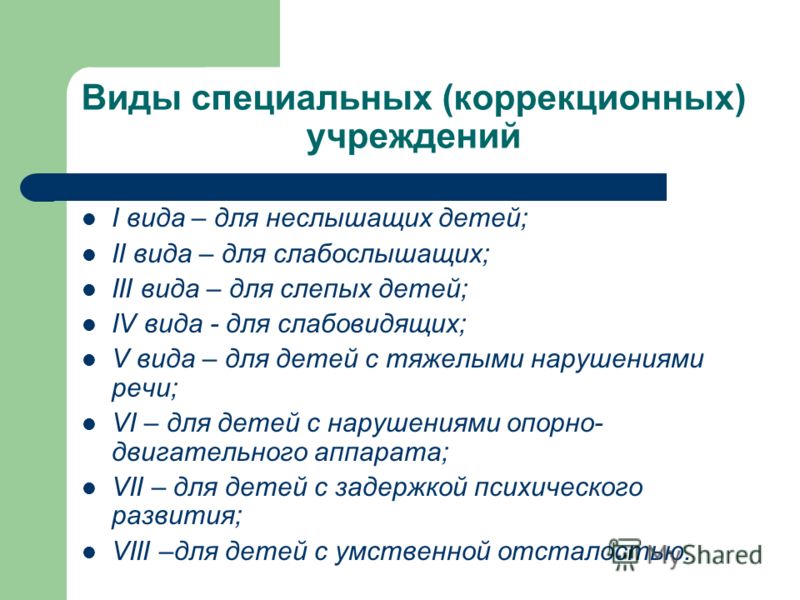
Types of special (correctional) institutions of the first type - for deaf children; Type II - for the hearing impaired; Type III - for blind children; Type IV - for the visually impaired; V type - for children with severe speech disorders; VI - for children with disorders of the musculoskeletal system; VII - for children with a delay mental development; VIII - for children with mental retardation.


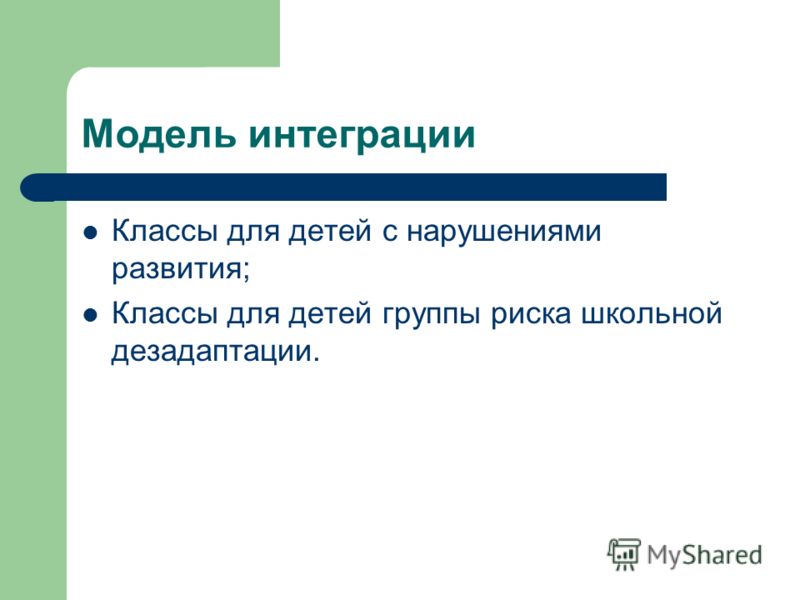
Classes for children with developmental disabilities with hearing impairments: deaf and hearing impaired; with visual impairment: blind and visually impaired; with severe speech disorders; with disorders of the musculoskeletal system; with mental retardation; mental retardation; with autism spectrum disorders;
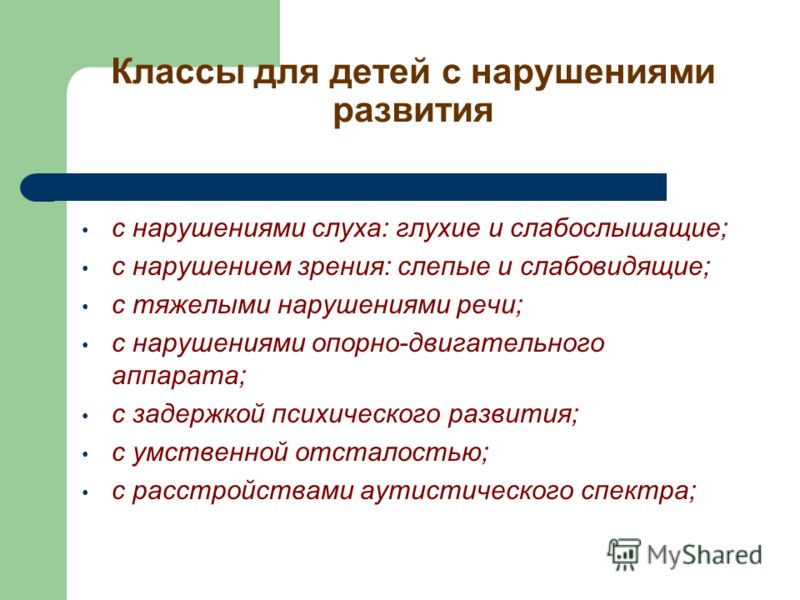
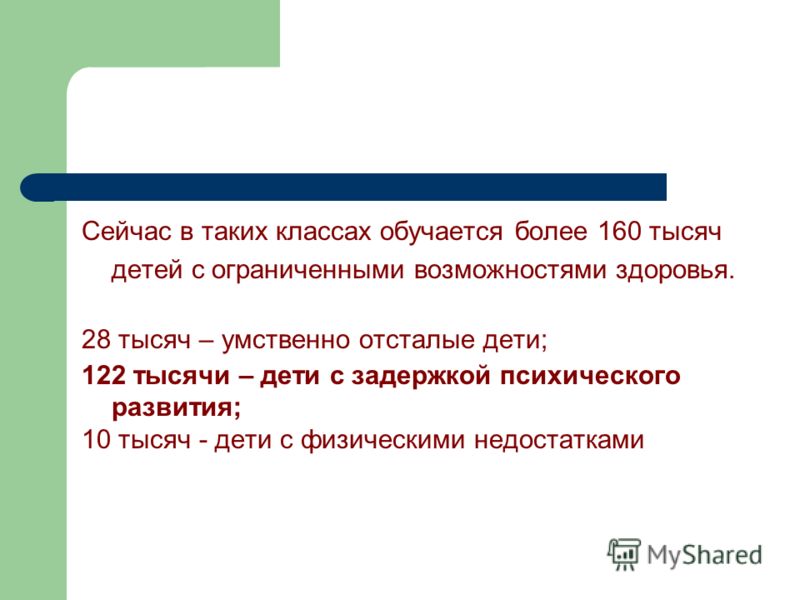
Children with mental retardation development of CRA - this is a slowdown in the development of the psyche of the child, which is expressed in the insufficiency of the general stock of knowledge, immaturity of thinking, the predominance of gaming interests, and the rapid satiety in intellectual activity. (children with the conclusion PMPK S (K) OU 7 species)

Classification of children with CRA 1.Intellektual'nye violations in connection with adverse environmental conditions and education or pathology of behavior; 2. Intellectual disturbances in long-term asthenic conditions caused by somatic diseases; 3. Violations in various forms of infantilism. 4. Secondary intellectual failure due to damage to hearing, vision, speech defects, reading, writing; 5. Functional-dynamic intellectual disorders in children in the residual stage and long-term infections and injuries of the central nervous system.

Characteristic deficiencies in the development of children with CRA (data from PMPK) are delayed and limited perception; impaired motor development; limitations speech development; deficiencies in the development of mental activity; insufficient cognitive activity compared with healthy children; gaps in knowledge and ideas about the world, interpersonal relationships; shortcomings in personal development (lack of self-confidence and unjustified dependence on others, low interpersonal skills, selfishness, pessimism and low or excessive self-esteem, inability to control one’s own behavior).
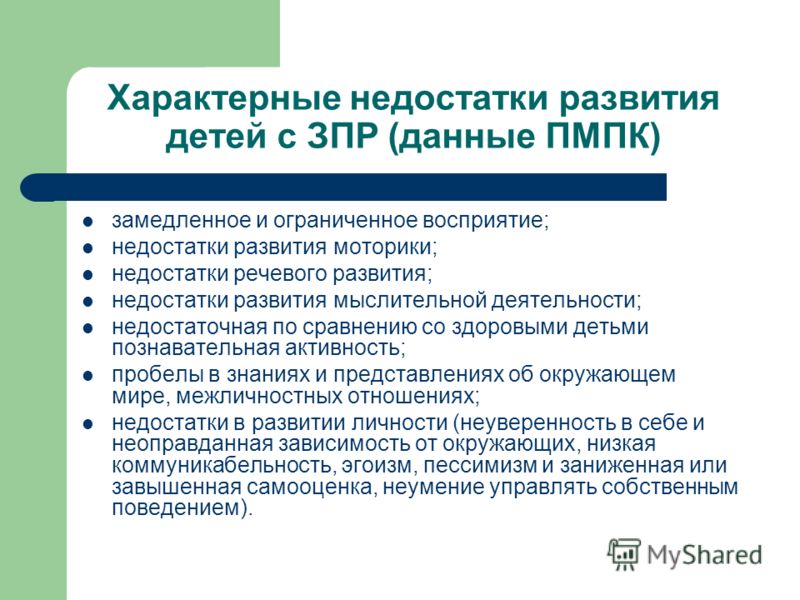
The organization and functioning of special (correctional) educational classes VII species. 1. Special (correctional) educational classes of type VII can be organized in all types. educational institutionslicensed to conduct educational activities on the implementation of special (correctional) programs. 2. Special (correctional) educational classes of the VII type open mainly at the primary education level at the beginning of the first or second year of study and can function until the children receive basic general education. 3. Functioning 3. Functioning of special (correctional) educational classes VII of the type at the stage of basic general education is permissible in the following cases: - when at earlier stages of age development, education did not provide correctional assistance to children; - when a child has been studying in a special class for less than two years; - when, due to the complexity of the violation, the presence of deviations in the emotional-volitional sphere, behavioral and psychological problems, the child’s stay in the conditions of the general education class has a negative impact on the efficiency of the development of general education programs by the other students in the class.
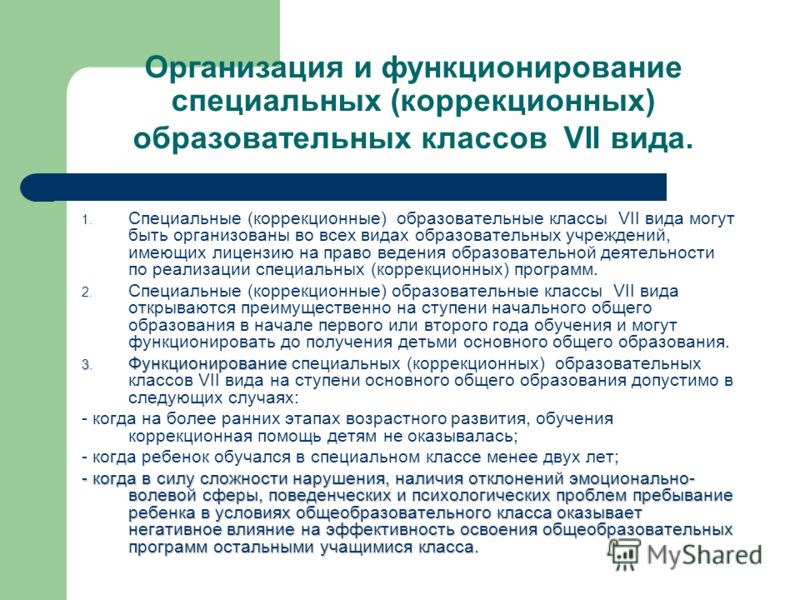
The organization and functioning of special (correctional) educational classes VII species. 4. With the positive dynamics of development and successful development of the curriculum to address the regional (municipal) psychological, medical and educational Commissions of students of special (correctional) educational classes VII of the form can be transferred to regular general education classes. 5. The maximum occupancy of special (correctional) educational classes VII of the form of 12 people. The increase in the number of students in these classes is unacceptable as a result of deterioration educational process and violation of children's rights to education. 6. The main tasks of special (correctional) educational classes of the VII type are: normalization learning activities, activization of cognitive activity, improvement of the level of mental development, correction of deficiencies in emotional-personal and social development, social and labor adaptation of students.
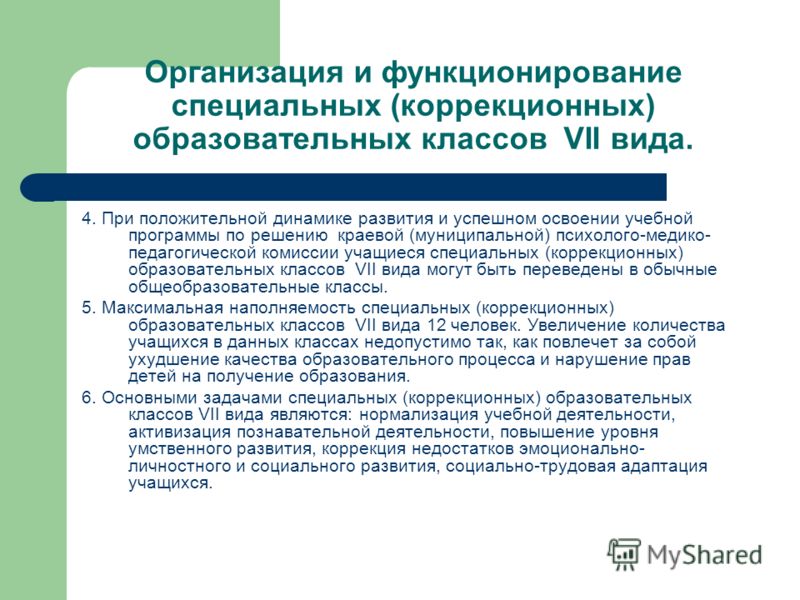
The organization and functioning of special (correctional) educational classes VII species. 7 Educational programs for students of special (correctional) educational classes of type VII, they are developed on the basis of the main general educational programs taking into account their capabilities and peculiarities of psychophysical development. 8. The state (final) certification for pupils of classes of the VII type is carried out in the traditional form. 9. Graduates who have successfully completed the course of basic school receive a standard document on obtaining basic general education.
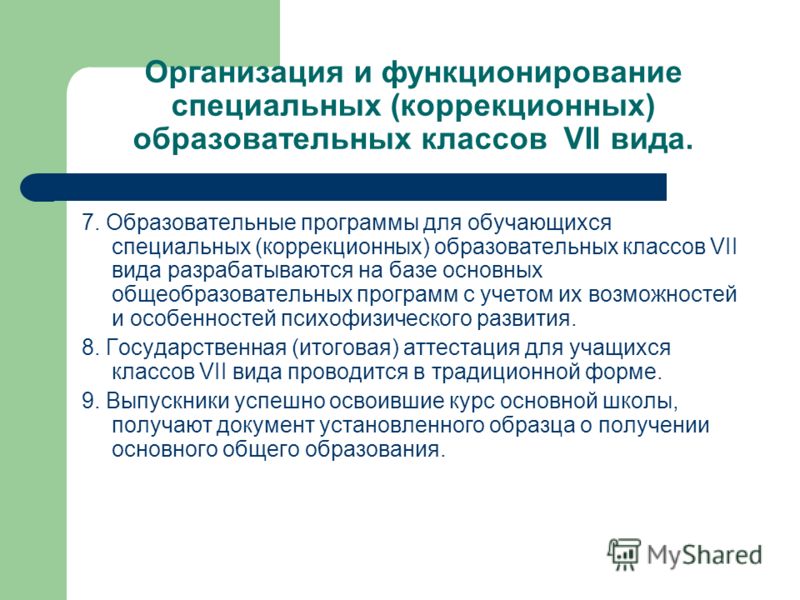
Classes of compensatory education (for children at risk of social maladjustment) are somatically weakened: often ill, with severe chronic diseases; psychologically unprepared for schooling; socially neglected; with low adaptive capacity, etc.

Characteristic deficiencies in the development of children at risk of school maladaptation; Lack of pronounced developmental disabilities; Intellectual development is age appropriate; Low performance, fatigue and distractibility; Impulsiveness; Hyperactivity: Low level of arbitrariness of mental functions and activities; Unformed learning motivation and cognitive interests; Difficulties of regulation and planning of own activities; Manifestations of deviations in behavior.
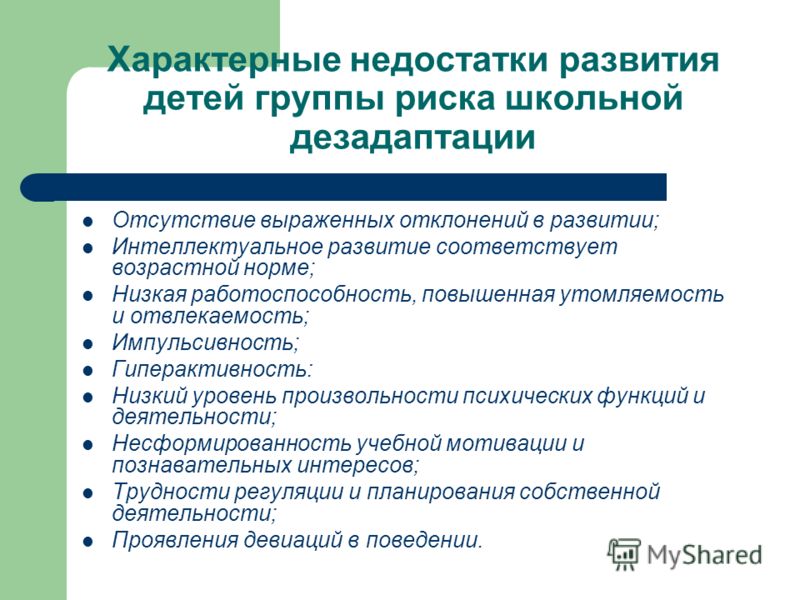
Provision on compensatory training classes in general educational institutions of the Trans-Baikal Territory 1. Compensatory training classes can be organized in all types of general educational institutions with the necessary personnel and material and technical conditions. Compensatory training classes are opened at the suggestion of the pedagogical council of the general education institution on the basis of the order of the director. 2. Compensatory training classes are created primarily at the primary education level at the beginning of the first or second year of study. 3. The occupancy of the class compensating training is from 12 to 20 people. 4. Students who have mastered the program of general education subjects in compensatory training classes, by decision psycho-pedagogical Consulia are transferred to the appropriate class of general educational institution, working on the basic general educational programs.
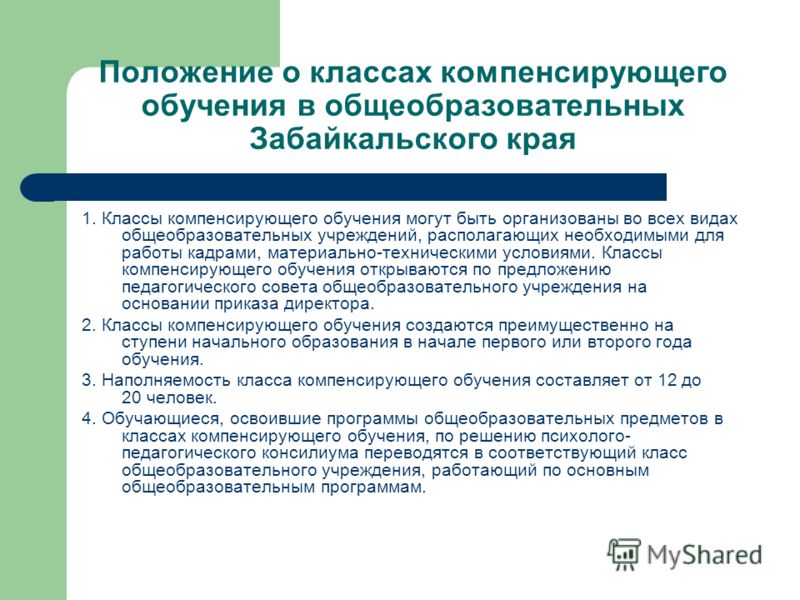
The provision on compensatory education classes in general education in the Trans-Baikal Territory 5. General education programs are implemented in compensatory education classes. An integral part of the activities of compensatory training classes is the program of diagnostic and correctional and developmental work, which is implemented both in the process of educational and extracurricular activities with students. 6. The state (final) certification for pupils of classes of compensatory education is conducted in the traditional form. Students of compensatory training classes pass the final certification on a general basis.

General principles and rules remedial work: 1. Individual approach to each student. 2. Prevention of onset of fatigue, using various means for this (alternating mental and practical activities, presenting the material in small doses, using interesting and colorful didactic material and visual aids). 3. The use of methods that activate students' cognitive activity, develop their oral and written speech and form the necessary learning skills. 4. The manifestation of pedagogical tact. Constant encouragement for the slightest success, timely and tactical assistance to each child, the development in it of faith in their own strengths and capabilities.

The teacher must: monitor the performance of students: after each part of the new educational material to check whether his child understood; put the child on the first grade, as close as possible to the teacher, as eye contact enhances attention; support children, develop positive self-esteem in them, correctly making a remark if something is done incorrectly; allow learners to write down various steps when performing exercises.
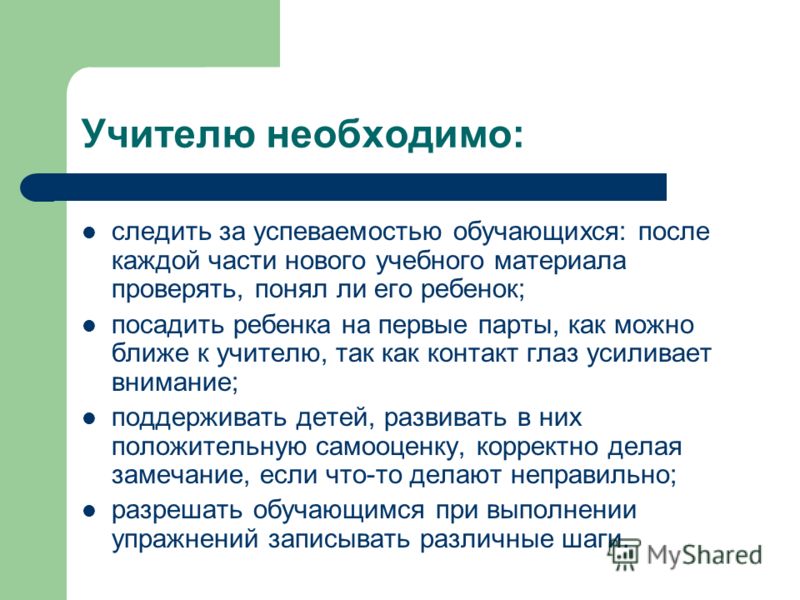

1. General Provisions
1.1. Special (correctional) classVII This form is a form of differentiation of education, which allows solving the tasks of timely active assistance to children with learning difficulties and adaptation to school in the system of basic general education.
1.2. Correctional classVII of the species is created for the education and upbringing of children with mental retardation, who, with potentially safe opportunities intellectual development there is a weakness of memory, attention, lack of pace and mobility of mental processes.
1.3. The purpose of organizing these classes is to create a complete system at school that provides optimal conditions for children with mental retardation in accordance with their age and individual typological features, state of somatic and neuropsychic health. In this system, the diagnostic and consultative, corrective and developmental, therapeutic and prophylactic, social and labor activities interact.
1.4. Activity classesVII The species is built in accordance with the principles of humanization and ensures the adequacy and variability of the educational system, the integration of special and general education.
2. Organization and operation
2.1. Classes VII of a type can be opened in a comprehensive school of any type and type if there are personnel specially trained for this work, scientific and methodological support, an appropriate material and technical base for organizing learning process and therapeutic and preventive care for children and adolescents with mental retardation.
2.2. Classes VII The species is opened by order of the school director on the basis of the conclusion of the PMPK for each child
2.3. Enrollment in classesVII the type is made only with the consent of the parents (legal representatives) on the basis of their application.
2.4. Classes VII The species opens mainly at the primary education level at the beginning of the second year of study and functions up to the 9th grade inclusive.
2.5. With a positive developmental dynamics and successful mastering of the curriculum under the decision of the PMPK studentsVII the species can be transferred to regular classes with the consent of the students themselves and their parents (legal representatives).
2.6. Learning classesVII A species can attend elective, group and other activities organized for students in regular classes.
2.7. The daily routine of students in classesVII the type is set taking into account the increased fatigue of the contingent of students. The work of these classes is organized in 1 shift in the mode of extended day with the organization of free two meals a day and the necessary recreational activities.
2.8. The occupancy of the class-group - up to 12 people.
2.9. Comprehensive study of students in classesVII species, dynamic observation of them is carried out by the school PMPK.
2.10. Graduates of the 9th grade, who have successfully completed the course of basic school, receive a standard document on obtaining basic general education.
2.11. Students in the classroomVII species that cannot cope with the curriculum can be defined in correctional classes according to the decision of the urban PMPK and with the consent of the parents (legal representatives)Viii type or classes of integrated education (classes of joint education of children with standard educational needs and children with special educational needs).
3. Educational process
3.1. The correctional educational process is regulated by the Model Basic Curriculum of an educational institution for children with mental retardation, classes of correctional and developmental education, approved by the Ministry of Education Russian Federation and adapted to the peculiarities of the psycho-physiological development of children.
3.2. Training is organized both according to special textbooks for classes with mental retardation, and textbooks of mass classes, depending on the level of development of students. The teacher decides on this issue, coordinating it with the methodological council and school administration.
3.3. Teaching is conducted both according to educational programs of correctional classes, and programs of mass schools adapted to specific classes (children) and approved by the methodical council of the school.
3.4. Educational process in a correctional classVII the type is carried out in accordance with the levels of educational programs of two stages of general education:
I level - primary general education (standard development period - 4 years)
II level - basic general education (standard development period - 5 years).
3.5. Correctional training is carried out in all lessons and should ensure the assimilation of educational material in accordance with state educational standards.
3.6. The main objectives of remedial developmental education are:
Activization of students' cognitive activity;
Increase their level of mental development;
Normalization of educational activities;
Correction of deficiencies in emotional and personal development;
Socio-labor adaptation.
3.7. In order to correct deviations in development, eliminate gaps in knowledge, individual and group (no more than 3) remedial classes are held. For their use, the school component of the basic curriculum and the advisory hours for the extended day group are used.
3.8. For the provision of speech therapy in the state educational institution with classesVII the type of speech therapist is introduced at the rate of 1 staff unit for 25 people with speech disorders. Students having speech disorders, get speech therapy help on specially organized speech therapy classes individually and in groups of 4-6 people, as well as in subgroups of 2-3 people.
4. Staffing, material and financial support
4.1. For class workVII the type of teachers are appointed, having pedagogical experience of at least 3 years, who have undergone special training in the IPKRO or IRO, or having the appropriate specialization.
4.2. If necessary, to work with students of classesVII a view on contractual terms with additional funding may involve specialists who do not work in this educational institution (psychiatrist, psychotherapist and other specialists).
4.3. Classroom leadersVII kind of extra charge for classroom management in full.
4.4. Pedagogical workers, class specialistsVII of the type is set a surcharge in the amount of 15-20% of wage rates. School leaders with classesVII species that created the necessary conditions for their functioning, can also be set a premium from the above-tariff salary fund.
Adapted working programm
Primary general education in literary reading for grade 4,
Kabuzenko I.V.
EXPLANATORY NOTE
An adapted work program for literary reading was developed in accordance with the requirements of the FC GOS elementary general education, BUP, 2002, based on the author's literary reading program developed on the basis of the elementary general education program, the author program L. F. Klimanova, V.G. Goretsky, M. V. Golovanova (Programs for educational institutions / Correctional and developing education / M. Drofa, 2001). This program is implemented in a correctional class of a comprehensive school.
PSYCHOLOGICAL AND PEDAGOGICAL CHARACTERISTICS OF CHILDREN WITH A DELAY OF MENTAL DEVELOPMENT
This adapted educational program will be implemented in class IV of the CRA VII species. The program has a mechanism for the formation of functional literacy in children, which contributes to common development and child rearing. Actually, teaching reading involves working to improve reading skills, developing the perception of a literary text, and building reader independence. The success of studying the course of literature reading ensures the effectiveness of training in other subjects. elementary school. The program is focused on the formation and development of students with HVD (disabilities) VII type of speech skills, chief among which is the skill of reading.
The program takes into account the characteristics of children with HIA VII species.
The most prominent sign is the immaturity of the emotional-volitional sphere; It is very difficult for a child to make a willpower over himself, to force himself to do something.
Disturbance of attention: its instability, reduced concentration, increased distractibility. Attention disorders may be accompanied by increased motor and speech activity.
Violations of perception is expressed in the difficulty of building a holistic image. It may be difficult for a child to recognize objects known to him from an unfamiliar perspective. Such structural perception is the cause of insufficiency, limitation, knowledge about the surrounding world. Also affects the speed of perception and orientation in space.
Memory features: children remember visual material (non-speech) much better than verbal.
The delay of mental development is often accompanied by problems of speech associated with the pace of its development. Observed systemic underdevelopment of speech - a violation of its lexical and grammatical side.
In children with HIA VII species, there is a lag in the development of all forms of thinking; it is found primarily in the process of solving problems of verbal - logical thinking. By the beginning of schooling, children do not fully possess all the intellectual operations necessary for the performance of school tasks (analysis, synthesis, synthesis, comparison, abstraction)
Pupils in the class are characterized by poor health due to the constant manifestation of chronic diseases, increased fatigue
Correctional education in a secondary school
The system of specialized care for children with special educational needs. Training in a specialized institution (I-VIII type); Integrated training.
Types of special (correctional) institutions of the first type - for deaf children; Type II - for the hearing impaired; Type III - for blind children; Type IV - for the visually impaired; V type - for children with severe speech disorders; VI - for children with disorders of the musculoskeletal system; VII - for children with mental retardation; VIII - for children with mental retardation.
Integrated education Education in a special (correctional) class I - VIII type in a secondary school; Inclusive education.
Integration Model Classes for children with developmental disabilities; Classes for children at risk of school maladjustment.
Classes for children with developmental disabilities with hearing impairments: deaf and hearing impaired; with visual impairment: blind and visually impaired; with severe speech disorders; with disorders of the musculoskeletal system; with mental retardation; mental retardation; with autism spectrum disorders;
Now in such classes more than 160 thousand children with disabilities study. 28 thousand - mentally retarded children; 122 thousand - children with mental retardation; 10 thousand - children with physical disabilities
Children with mental retardation of mental retardation are a slowdown in the development of the child’s psyche, which is expressed in the insufficiency of the general stock of knowledge, immaturity of thinking, the predominance of play interests, and the rapid satiety in intellectual activity. (children with the conclusion PMPK S (K) OU 7 species)
Classification of children with CRA 1.Intellektual'nye violations in connection with adverse environmental conditions and education or pathology of behavior; 2. Intellectual disturbances in long-term asthenic conditions caused by somatic diseases; 3. Violations in various forms of infantilism. 4. Secondary intellectual failure due to damage to hearing, vision, speech defects, reading, writing; 5. Functional-dynamic intellectual disorders in children in the residual stage and long-term infections and injuries of the central nervous system.
Characteristic deficiencies in the development of children with CRA (data from PMPK) are delayed and limited perception; impaired motor development; impaired speech development; deficiencies in the development of mental activity; insufficient cognitive activity compared with healthy children; gaps in knowledge and ideas about the world, interpersonal relationships; shortcomings in personal development (lack of self-confidence and unjustified dependence on others, low interpersonal skills, selfishness, pessimism and low or excessive self-esteem, inability to control one’s own behavior).
The organization and functioning of special (correctional) educational classes VII species. Special (correctional) educational classes of the VII type can be organized in all types of educational institutions licensed to conduct educational activities for the implementation of special (correctional) programs. Special (correctional) educational classes of type VII are opened mainly at the primary education level at the beginning of the first or second year of study and can function until the children receive basic general education. The functioning of special (correctional) educational classes of type VII at the level of basic general education is permissible in the following cases: - when at earlier stages of age development, education was not provided for children; - when a child has been studying in a special class for less than two years; - when, due to the complexity of the violation, the presence of deviations in the emotional-volitional sphere, behavioral and psychological problems, the child’s stay in the conditions of the general education class has a negative impact on the efficiency of the development of general education programs by the other students in the class.
The organization and functioning of special (correctional) educational classes VII species. 4. With the positive dynamics of development and successful development of the curriculum to address the regional (municipal) psychological and medical pedagogical commission students of special (correctional) educational classes VII of the form can be transferred to ordinary general education classes. 5. The maximum occupancy of special (correctional) educational classes VII of the form of 12 people. The increase in the number of students in these classes is unacceptable, as it would entail a deterioration in the quality of the educational process and a violation of the rights of children to receive education. 6. The main tasks of special (correctional) educational classes of the VIIth type are: normalization of educational activities, activation of cognitive activity, raising the level of mental development, correction of deficiencies in emotional, personal and social development, social and labor adaptation of students.
The organization and functioning of special (correctional) educational classes VII species. 7. Educational programs for students of special (correctional) educational classes of the VII type are developed on the basis of the main general educational programs taking into account their capabilities and peculiarities of psychophysical development. 8. State (final) certification for pupils of classes VII of the form is carried out in the traditional form. 9. Graduates who have successfully completed the course of basic school receive a standard document on obtaining basic general education.
Classes of compensatory education (for children at risk of social maladjustment) are somatically weakened: often ill, with severe chronic diseases; psychologically unprepared for schooling; socially neglected; with low adaptive capacity, etc.
Characteristic deficiencies in the development of children at risk of school maladaptation; Lack of pronounced developmental disabilities; Intellectual development is age appropriate; Low performance, fatigue and distractibility; Impulsiveness; Hyperactivity: Low level of arbitrariness of mental functions and activities; Unformed learning motivation and cognitive interests; Difficulties of regulation and planning of own activities; Manifestations of deviations in behavior.
Provision on compensatory training classes in general educational institutions of the Trans-Baikal Territory 1. Compensatory training classes can be organized in all types of general educational institutions with the necessary personnel and material and technical conditions. Compensatory training classes are opened at the suggestion of the pedagogical council of the general education institution on the basis of the order of the director. 2. Compensatory training classes are created primarily at the primary education level at the beginning of the first or second year of study. 3. The occupancy of the class compensating training is from 12 to 20 people. 4. Students who have mastered the programs of general education subjects in classes of compensatory education, by the decision of psychological pedagogical consultation transferred to the appropriate class of general education institution working on the basic general education programs.
The provision on compensatory education classes in general education in the Trans-Baikal Territory 5. General education programs are implemented in compensatory education classes. An integral part of the activities of compensatory training classes is the program of diagnostic and correctional and developmental work, which is implemented both in the process of educational and extracurricular activities with students. 6. The state (final) certification for pupils of classes of compensatory education is conducted in the traditional form. Students of compensatory training classes pass the final certification on a general basis.
General principles and rules of correctional work: 1. Individual approach to each student. 2. Prevention of onset of fatigue, using various means for this (alternating mental and practical activities, presenting the material in small doses, using interesting and colorful didactic material and visual aids). 3. The use of methods that activate students' cognitive activity, develop their oral and written speech and form the necessary learning skills. 4. The manifestation of pedagogical tact. Constant encouragement for the slightest success, timely and tactical assistance to each child, the development in it of faith in their own strengths and capabilities.
The teacher must: monitor the performance of students: after each part of the new educational material to check whether his child understood; put the child on the first grade, as close as possible to the teacher, as eye contact enhances attention; support children, develop positive self-esteem in them, correctly making a remark if something is done incorrectly; allow learners to write down various steps when performing exercises.
All children can learn, which means that all of them, no matter how serious the developmental disabilities, should be given the opportunity to receive an education.

 Live journal
Live journal Facebook
Facebook Twitter
Twitter